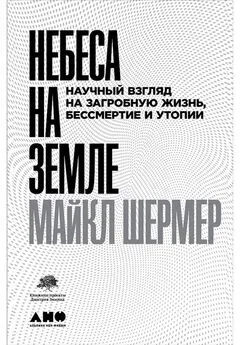Майкл Мобуссин - Больше, чем вы знаете. Необычный взгляд на мир финансов
- Название:Больше, чем вы знаете. Необычный взгляд на мир финансов
- Автор:
- Жанр:
- Издательство:Array Литагент «Альпина»
- Год:2014
- Город:Москва
- ISBN:978-5-9614-3247-3
- Рейтинг:
- Избранное:Добавить в избранное
-
Отзывы:
-
Ваша оценка:
Майкл Мобуссин - Больше, чем вы знаете. Необычный взгляд на мир финансов краткое содержание
Больше, чем вы знаете. Необычный взгляд на мир финансов - читать онлайн бесплатно ознакомительный отрывок
Интервал:
Закладка:
____. “The Science of Persuasion.” Scientific American, February 2001, 76–81.
Clancy, Barbara, and Barbara Finley. “Neural Correlates of Early Language Learning.” In Language Development: The Essential Readings, ed. Michael Tomasello and Elizabeth Bates, 307–30. Oxford: Blackwell, 2001. Предыдущая редакция этой главы доступна на сайте http://crl.ucsd.edu/courses/commdis/pdf/neuralcorrelateschapter-nofigures.pdf.
Coen, Corinne, and Rick Riolo. “El Farol Revisited: How People in Large Groups Learn to Coordinate Through Complementary Scripts.” Organizational Learning and Knowledge Management conference proceedings, 4th International Conference, June 2001, London, Ont.
Colinvaux, Paul. Why Big Fierce Animals Are Rare. Princeton, N. J.: Princeton University Press, 1978.
Collins, Jim. Good to Great. New York: HarperBusiness, 2001.
Cornell, Bradford. The Equity Risk Premium: The Long-Run Future of the Stock Market. New York: Wiley, 1999.
Corporate Strategy Board. “Stall Points: Barriers to Growth for the Large Corporate Enterprise.” Corporate Strategy Board (March 1998).
Coy, Peter. “He Who Mines the Data May Strike Fool’s Gold.” BusinessWeek, June 16, 1997.
Crist, Steven. Betting on Myself: Adventures of a Horseplayer and Publisher. New York: Daily Racing Form Press, 2003.
Cutler, David M., James M. Poterba, and Lawrence H. Summers. “What Moves Stock Prices?” Journal of Portfolio Management (Spring 1989): 4–12.
Damasio, Antonio R. Descartes’ Error: Emotion, Reason, and the Human Brain. New York: Avon Books, 1994.
____. The Feeling of What Happens: Body and Emotion in the Making of Consciousness. New York: Harcourt Brace & Company, 1999.
Darwin, Charles. The Origin of Species. London: John Murray, 1859.
Davis, Bob, and Susan Warren. “How Fears of Impending War Already Take Economic Toll.” The Wall Street Journal, January 29, 2003.
DeBondt, Werner, and Richard Thaler. “Does the Stock Market Overreact?” Journal of Finance 40 (1985): 793–805.
DellaVigna, Stefano, and Joshua Pollet. “Attention, Demographics, and the Stock Market.” Working Paper, November 23, 2003. http://fisher.osu.edu/fin/dice/seminars/pollet.pdf.
DeLong, J. Bradford, Andrei Shleifer, Lawrence H. Summers, and Robert J. Waldmann. “Positive Feedback Investment Strategies and Destabilizing Rational Speculation.” Journal of Finance 45, no. 2 (June 1990): 379–95.
DeLong, J. Bradford, and Lawrence H. Summers. “The ‘New Economy’: Background, Historical Perspective, Questions, and Speculations.” Federal Reserve Bank of Kansas City Economic Review (Fourth Quarter 2001).
Dembo, Ron S., and Andrew Freeman. Seeing Tomorrow: Rewriting the Rules of Risk. New York: Wiley, 1998.
Dickinson, Rod. “The Milgram Reenactment.” http://www.milgram reenactment.org /pages/section.xml?location51.
Dimson, Elroy, Paul Marsh, and Mike Staunton. “Global Evidence on the Equity Risk Premium.” Journal of Applied Corporate Finance 15, no. 4 (Fall 2003): 27–38.
Dugatkin, Lee Alan. The Imitation Factor: Evolution Beyond the Gene. New York: Free Press, 2000.
Dugatkin, Lee Alan, and Jean-Guy J. Godin. “How Females Choose Their Mates.” Scientific American (April 1998): 56–61.
Durand, David. “Growth Stocks and the Petersburg Paradox.” Journal of Finance 12 (September 1957): 348–63.
The Economist. “Other People’s Money: A Survey of Asset Management.” July 5, 2003.
____. “Survey of the ‘New Economy.’” September 21, 2000.
Eguiluz, Victor M., and Martin G. Zimmerman. “Transmission of Information and Herd Behavior: An Application to Financial Markets.” Physical Review Letters 85, no. 26 (December 2000): 5659–62.
Ehrlich, Paul R. Human Natures: Genes, Cultures, and the Human Prospect. Washington, D. C.: Island Press, 2000.
Eisenhardt, Kathleen M., and Donald N. Sull. “Strategy as Simple Rules.” Harvard Business Review (January 2001): 107–16.
Ellis, Charles D. “Will Business Success Spoil the Investment Management Profession?” The Journal of Portfolio Management (Spring 2001): 11–15. Elton, Charles S. Animal Ecology. Chicago: The University of Chicago Press, 2001.
Enriquez, Juan, As the Future Catches You. New York: Crown Business, 2000.
Epstein, Richard A. The Theory of Gambling and Statistical Logic. London: The Academic Press, 1977.
Epstein, Seymour. “Cognitive-Experiential Self-Theory: An Integrative Theory of Personality.” In The Relational Self: Theoretical Convergences in Psychoanalysis and Social Psychology, ed. R. C. Curtis, 111–37. New York: Guilford Press, 1991.
____. “Integration of the Cognitive and the Psychodynamic Unconscious.” American Psychologist 49, no. 8 (August 1994): 709–24.
Erickson, Todd, Carin Cooney, and Craig Sterling. “US Technology Sector: Mean Reversion Analysis.” CSFB HOLT Research, February 2, 2004.
Falconer, Ian. Olivia. New York: Atheneum Books for Young Readers, 2000.
Fama, Eugene F., Lawrence Fisher, Michael C. Jensen, and Richard Roll. “The Adjustment of Stock Prices to New Information.” International Economic Review 10, no. 1 (February 1969).
Fama, Eugene F., and Kenneth R. French. “Disappearing Dividends: Changing Firm Characteristics or Lower Propensity to Pay?” CRSP Working Paper 509. June 2000. http://papers.ssrn.com/so3/papers.cfm?abstract_id=203092.
____. “The Equity Premium.” Journal of Finance 57 (2002): 637–59.
Farmer, J. Doyne, and Fabrizio Lillo. “On the Origin of Power Law Tails in Price Fluctuations.” Quantitative Finance 4, no. 1 (2004): 7–11.
Fauconnier, Gilles, and Mark Turner. The Way We Think: Conceptual Blending and the Mind’s Hidden Complexities. New York: Basic Books, 2002.
Fehr, Ernst. “The Economics of Impatience.” Nature, January 17, 2002, 269–70.
Feltovich, Paul J., Kenneth M. Ford, and Robert Hoffman, eds. Expertise in Context: Human and Machine. Menlo Park, Cal.: AAAI Press and Cambridge, Mass.: MIT Press, 1997.
Fine, Charles H. Clockspeed: Winning Industry Control in the Age of Temporary Advantage. Reading, Mass.: Perseus Books, 1998.
Fisher, Kenneth L., and Meir Statman. “Cognitive Biases in Market Forecasts.” Journal of Portfolio Management 27, no. 1 (Fall 2000): 72–81.
Fisher, Lawrence, and James H. Lorie. “Rates of Return on Investments in Common Stocks.” Journal of Business 37, no. 1 (January 1964): 1–24.
Foderaro, Lisa W. “If June Cleaver Joined ‘Sex and the City’: Tupperware Parties for the Cosmo Set.” New York Times, February 1, 2003.
Foster, Richard, and Sarah Kaplan. Creative Destruction: Why Companies that Are Built to Last Underperform the Market – and How to Successfully Transform Them. New York: Doubleday, 2001.
Fuller, Joseph, and Michael C. Jensen. “Dare to Keep Your Stock Price Low.” The Wall Street Journal, December 31, 2001.
Galton, Francis. “Vox Populi.” Nature 75 (March 1907): 450–451. Reprint, 1949.
Gawande, Atul, Complications: A Surgeon’s Notes on an Imperfect Science. New York: Picador, 2002.
Gazzaniga, Michael. “The Whole-Brain Interpreter.” http://pegasus.cc.ucf.edu/~fle/gazzaniga.html.
Gell-Mann, Murray. The Quark and the Jaguar: Adventures in the Simple and the Complex. New York: W. H. Freeman, 1994.
Gibson, Michael S. “Incorporating Event Risk into Value-at-Risk.” The Federal Reserve Board Finance and Economics Discussion Series, 2001–17, February 2001. http://www.federalreserve.gov/pubs/feds/2001/200117/200117abs.html.
Gigerenzer, Gerd. Calculated Risks. New York: Simon & Schuster, 2002.
Gillon, S. The Story of the 29th Division. London: Nelson & Sons, n. d.
Gilovich, Thomas, Dale Griffin, and Daniel Kahneman, eds. Heuristics and Biases: The Psychology of Intuitive Judgment. Cambridge: Cambridge University Press, 2002.
Gilovich, Thomas, Robert Valone, and Amos Tversky. “The Hot Hand in Basketball: On the Misperception of Random Sequences.” Cognitive Psychology 17 (1985): 295–314.
Gladwell, Malcolm. The Tipping Point: How Little Things Can Make a Big Difference. Boston, Mass.: Little, Brown and Company, 2000.
Glassman, James K., and Kevin A. Hassett. Dow 36,000: The New Strategy for Profiting from the Coming Rise in the Stock Market. New York: Times Books, 1999.
GloriaMundi. “Introduction to VaR.” http://www.gloriamundi.org/introduction. asp.
Goodgame, Dan. “The Game of Risk: How the Best Golfer in the World Got Even Better.” Time, August 14, 2000.
Gopnik, Alison, Andrew Meltzoff, and Patricia Kuhl. The Scientist in the Crib: What Early Learning Tells Us About the Mind. New York: First Perennial, 2001.
Gould, Stephen Jay. “The Streak of Streaks.” New York Review of Books, August 18, 1988. http://www.nybooks.com/articles/4337.
____. Triumph and Tragedy in Mudville. New York: W. W. Norton, 2003.
Graham, Benjamin. “Stock Market Warning: Danger Ahead!” California Management Review 11, no. 3 (Spring 1960).: 34.
Graham, Benjamin, and David L. Dodd. Security Analysis. New York: McGraw Hill, 1934.
Greenspan, Alan. “The Structure of the International Financial System.” Выступление на ежегодном собрании Ассоциация индустрии ценных бумаг. 5 ноября 1998 г. http://www.federalreserve.gov/boarddocs/speeches/1998/19981105.htm.
Greenwald, John. “Doom Stalks the Dotcoms.” Time, April 17, 2000.
Griffin, Dale, and Amos Tversky. “The Weighing of Evidence and the Determinants of Confidence.” In Heuristics and Biases: The Psychology of Intuitive Judgment, ed. Thomas Gilovich, Dale Griffin, and Daniel Kahneman, 230–49. Cambridge: Cambridge University Press, 2002.
Grossman, Sanford J., and Joseph E. Stiglitz. “On the Impossibility of Informationally Efficient Markets.” American Economic Review 70 (1980): 393–408.
Haffner, Katie. “In an Ancient Game, Computing’s Future.” New York Times, August 1, 2002.
Hanson, Robin D. “Decision Markets.” IEEE Intelligent Systems (May – June 1999): 16–19. http://hanson.gmu.edu/decisionmarkets.pdf.
Hargadon, Andrew. How Breakthroughs Happen. Boston: Harvard Business School Press, 2003.
Hayek, Freidrich. “The Use of Knowledge in Society.” American Economic Review 35, no. 4 (September 1945): 519–30. http://www.virtualschool.edu/mon/Economics/HayekUseOfKnowledge.html.
Holland, John H. Hidden Order: How Adaptation Builds Complexity. Reading, Mass.: Helix Books, 1995.
Hollywood Stock Exchange. Web site. http://www.hsx.com.
Huberman, Bernardo A. The Laws of the Web: Patterns in the Ecology of Information. Cambridge, Mass.: MIT Press, 2001.
Hulbert, Mark. “The Five-Year Forecast Looks Great, or Does It?” New York Times, January 25, 2004.
IBM Research. “Deep Blue: FAQ.” http://www.research.ibm.com/deepblue/meet/html/d.3.3.html.
Idinopulos, Michael, and Lee Kempler. “Do You Know Who Your Experts Are?” The McKinsey Quarterly 4 (2003): 60–69.
Ijiri, Yuji, and Herbert A. Simon. Skew Distributions and the Sizes of Firms. New York: North-Holland, 1977.
Innocentive. Web site. http://www.innocentive.com.
Iowa Electronic Markets. Web site. http://www.biz.uiowa.edu/iem.
Janis, Irving Lester. Groupthink: Psychological Studies of Policy Decisions and Fiascoes. New York: Houghton Mifflin, 1982.
Jensen, Michael C. “The Performance of Mutual Funds in the Period 1945–1964.” Journal of Finance 23 (1968): 389–416.
Jilek, Paddy, Bradford Neuman, and Arbin Sherchan. “U. S. Investment Digest: Five Tidbits.” Credit Suisse First Boston Equity Research, September 5, 2003.
Читать дальшеИнтервал:
Закладка:










